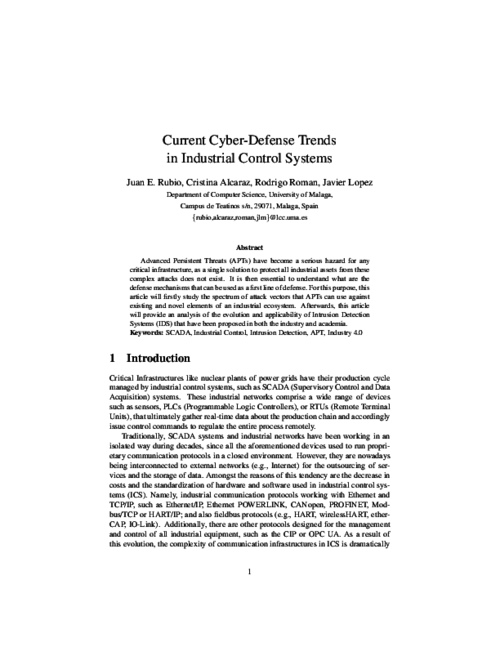 ] Type Year
] Type Year Computers & Security Journal, vol. 87, Elsevier, 11/2019. DOI
Abstract
Advanced Persistent Threats (APTs) have become a serious hazard for any critical infrastructure, as a single solution to protect all industrial assets from these complex attacks does not exist. It is then essential to understand what are the defense mechanisms that can be used as a first line of defense. For this purpose, this article will firstly study the spectrum of attack vectors that APTs can use against existing and novel elements of an industrial ecosystem. Afterwards, this article will provide an analysis of the evolution and applicability of Intrusion Detection Systems (IDS) that have been proposed in both the industry and academia.

IEEE Communications Surveys and Tutorials, vol. 20, issue 4, IEEE, pp. 3453-3495, 07/2018. DOI
Abstract
As the deployment of Internet of Things (IoT) is experiencing an exponential growth, it is no surprise that many recent cyber attacks are IoT-enabled: The attacker initially exploits some vulnerable IoT technology as a first step towards compromising a critical system that is connected, in some way, with the IoT. For some sectors, like industry, smart grids, transportation and medical services, the significance of such attacks is obvious, since IoT technologies are part of critical backend systems. However, in sectors where IoT is usually at the enduser side, like smart homes, such attacks can be underestimated, since not all possible attack paths are examined. In this paper we survey IoT-enabled cyber attacks, found in all application domains since 2010. For each sector, we emphasize on the latest, verified IoT-enabled attacks, based on known real-world incidents and published proof-of-concept attacks. We methodologically analyze representative attacks that demonstrate direct, indirect and subliminal attack paths against critical targets. Our goal is threefold: (i) To assess IoT-enabled cyber attacks in a risk-like approach, in order to demonstrate their current threat landscape; (ii) To identify hidden and subliminal IoT-enabled attack paths against critical infrastructures and services, and (iii) To examine mitigation strategies for all application domains.